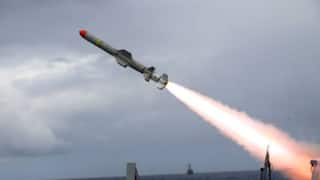Artemis I Launch Highlights: NASA Artemis I Launch Called Off Due To Technical Issues With SLS Rocket Engine
Artemis I: NASA was set to launch Artemis I, the first leg of the Artemis Moon mission, on August 29, 2022. However, the mission was scrubbed due to technical issues with one of the engines of SLS.

Background
Artemis I: NASA is set to launch Artemis I, the first leg of the Artemis Moon mission, on August 29, 2022. The first integrated test of NASA's deep space exploration systems, Artemis I is an uncrewed flight that will provide a foundation for human deep space exploration.
Artemis I will take off from Launch Pad 39B at NASA's Kennedy Space Center in Florida. The launch window will remain open from 8:33 am EDT to 10:33 am EDT (6:03 pm IST to 8:03 pm IST) on August 29.
The Orion spacecraft, Space Launch System (SLS) rocket, and the ground systems at NASA's Kennedy Space Center in Florida are the US space agency's deep space exploration systems.
The Artemis project, the first human moon mission since 1972, aims to carry the first woman, and the first person of colour to the Moon, by 2024.
The first spaceflight that landed humans on the lunar surface was Apollo 11 on July 20, 1969, and the last one was Apollo 17 on December 11, 1972.
Artemis, the Goddess of the Moon in Greek Mythology, after whom NASA's upcoming Moon mission has been named, was the twin sister of Apollo.
The objective behind the Artemis Mission is that it will enable NASA to demonstrate new technologies on the Moon, which will pave the way for future exploration of Mars.
The Artemis Mission has three stages, Artemis I, II, and III.
NASA's massive SLS rocket and Orion Space Capsule will carry astronauts into lunar orbit. From there, SpaceX's Human Lander System (HLS) will ferry the astronauts to the Moon's icy south pole.
What Is Artemis I All About?
Artemis I will be an uncrewed test flight. Orion will be carried atop the super-heavy lift rocket, SLS, without any human in the capsule. If Artemis I is successful, it will be certified that the SLS and Orion can be used for the other two Artemis missions, which will be crewed flights.
The duration of Artemis I will be 42 days, three hours, and 20 minutes. Orion will launch atop SLS, the most powerful rocket in the world, and will fly farther than any spacecraft built for humans has ever flown. Over the course of the mission, Orion will travel a distance of approximately 4,50,000 kilometres from Earth and 64,000 kilometres beyond the far side of the Moon. The spacecraft will stay in space longer than any human spacecraft has without docking to a space station. Orion will also return home faster and hotter than ever before.
Artemis I will demonstrate the performance of both Orion and SLS and test NASA's capabilities to orbit the Moon and return to Earth. The first uncrewed test flight of the Artemis Program will pave the way for future missions to the lunar vicinity, including landing the first woman and the first person of colour on the surface of the Moon.
The objective of Artemis I is to set the stage for human exploration into deep space, where astronauts will build and begin testing the systems near the Moon needed for lunar exploration missions and to other destinations farther from Earth, including the Red Planet.
Where Is Artemis I Headed?
Orion will blast off into space atop SLS, from Launch Pad 39B at NASA's modernised spaceport at Kennedy Space Center. SLS will be propelled by a pair of five-segment boosters and four RS-25 engines, and will reach the period of greatest atmospheric force within 90 seconds. After approximately two minutes, the solid rocket boosters will burn through their propellant and separate from the rocket. After approximately eight minutes, the core stages and RS-25 engines will deplete the propellant.
Therefore, the core stage engines will jettison the boosters, service module panels, and launch abort system, and then shut down. After this, the core stage will separate from the spacecraft. This will leave Orion attached to the interim cryogenic propulsion stage (ICPS) that will propel the spacecraft toward the Moon. It is a single-engine hydrogen- or liquid oxygen-based system that provides in-space propulsion after the solid rocket boosters and core stage are jettisoned.
As Orion orbits Earth and deploys its solar arrays, the ICPS will give the spacecraft the big push it needs to leave Earth's orbit and travel toward the planet's natural satellite. This manoeuvre is known as trans-lunar injection, according to NASA. The manoeuvre targets a point about the Moon that will guide Orion close enough to be captured by the Moon's gravity.
Artemis I Launch Highlights: NASA Artemis I Launch Called Off Due To Technical Issues With SLS Rocket Engine
The launch of Artemis I on Monday, August 29, was scrubbed due to a technical problem with one of the engines of the Space Launch System (SLS) rocket. As a result, the first leg of NASA’s Moon mission has been postponed.
NASA said in a mission update that the US space agency will keep everyone posted on the timing of the next launch attempt.
The launch director halted Monday's launch attempt of Artemis I at approximately 8:34 am EDT (6:04 pm IST).
A few hours before the launch attempt, NASA engineers were troubleshooting a conditioning issue with one of the RS-25 engines of the SLS, the world's most powerful rocket. Launch controllers increased the pressure on the core stage tanks to condition the engines, and to cause some of the cryogenic propellant to bleed to the engines. This is an important step because it ensures the engines can reach the proper temperature range to get started.
However, NASA teams observed an issue with the bleeding of engine number 3. As a result, the mission was scrubbed.
Artemis I Launch LIVE: Monday's Launch Attempt Scrubbed Due To Malfunctioning Of SLS Engine, Mission Postponed
Monday's launch attempt of Artemis I was scrubbed due to an issue in engine number 3 of the Space Launch System (SLS) rocket. Therefore, the first leg of NASA's Moon mission has been postponed to Friday, September 2.
The launch of #Artemis I is no longer happening today as teams work through an issue with an engine bleed. Teams will continue to gather data, and we will keep you posted on the timing of the next launch attempt. https://t.co/tQ0lp6Ruhv pic.twitter.com/u6Uiim2mom
— NASA (@NASA) August 29, 2022





































